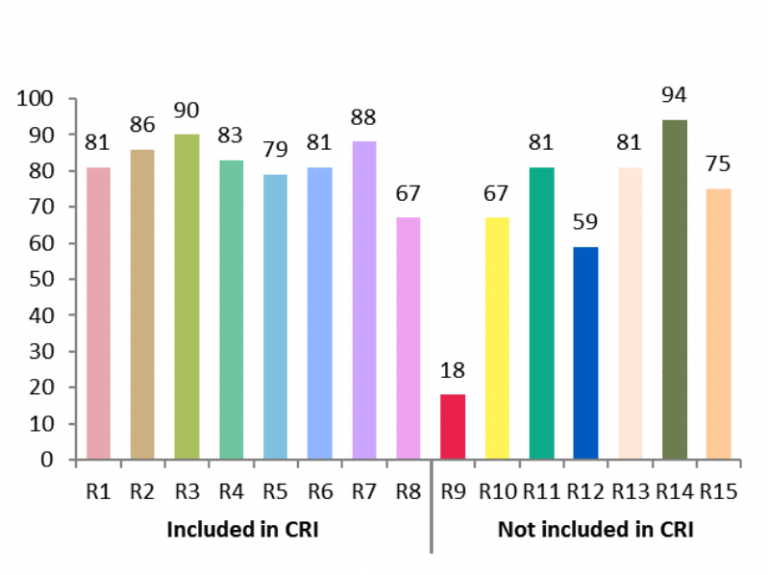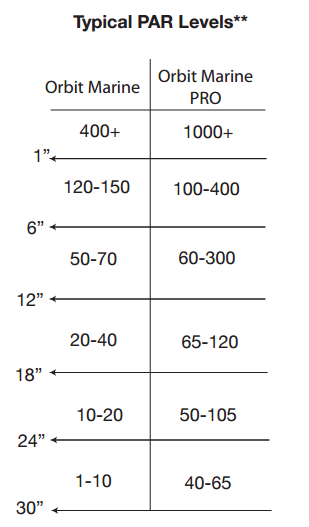Comparing horticultural lighting can be a lot like comparing apples to oranges. Not only is there a big difference in the actual light technologies (LEDs, HIDs, fluorescents, plasmas, etc.) used by horticulturists, there is a big difference in the way horticultural lighting manufacturers advertise the light output of their products. For example, PAR ratings, CRI ratings, Kelvin ratings, and lumen outputs are all used by manufacturers to showcase their particular product’s light output. Understandably, this can be confusing for novice indoor horticulturists as it is difficult to compare technologies without an established standard in the industry. A good starting point for a novice grower is to familiarize him- or herself with three terms used by horticultural lighting manufacturers and indoor growers. Those three terms are CRI (color rendition index), PAR (photosynthetically active radiation), and PPFD (photosynthetic photon flux density). The first two, CRI and PAR, are normally used by light manufacturers to express the spectral output of their products. The third, PPFD, is a unit of measurement commonly used by indoor growers to ensure the indoor garden is receiving enough light and to compare various lighting technologies.

Color Rendition Index (CRI)
The color rendition index quantitatively measures the ability of a light source to reveal colors faithfully in comparison with an ideal or natural light source. Essentially, the sun is viewed as the ideal natural light source. This means that a horticultural lamp with a high CRI rating will provide a spectrum of light that more closely resembles the sun’s spectrum than a horticultural lamp with a lower CRI rating. The CRI is determined by the light source’s spectrum. However, just because an artificial light source has a high CRI rating doesn’t necessarily mean it will outperform a light source with a lower CRI rating in a horticultural application. Plants “use” light differently than humans do. There are particular ranges of the light spectrum that are more useful to plants than others. A horticultural light source may emit a spectrum that peaks in the light spectrum that plants are able to use most efficiently. Although that horticultural light provides more usable energy to the plants, it would likely have a relatively low CRI rating as the spectrum output may appear unnatural.
Photosynthetically Active Radiation (PAR)
The term PAR refers directly to the spectrums or wavelengths of light that are most usable by plants for photosynthesis. When discussing wavelengths of light, the wavelength is commonly represented in nanometers (nm). A nanometer is a measurement equal to one billionth of a meter. The visible light range for humans falls between 390 nm and 700 nm. This is very similar to the PAR range for plants, which falls in the 400-700 nm range. However, the range of PAR is still a relative measurement as plants are actually more or less sensitive to particular wavelengths within the range of PAR. The pigments, chlorophyll A, chlorophyll B, and beta-carotene, found in plants are responsible for capturing most of the light for photosynthesis. Each of these pigments have specific peak absorption wavelengths or particular spectrums they are most efficient at using for photosynthesis.It has been discovered that these pigments are most efficient at capturing particular light wavelengths that fall in the blue and red bands of light. Chlorophyll A, chlorophyll B, and beta-carotene are not very efficient at capturing green and yellow light. By breaking down the nanometer ranges that represent each visible color spectrum, we can get a better idea as to which spectrum(s) best stimulate the pigments during photosynthesis.

Violet Light (320-430 nm)
Both chlorophyll A and chlorophyll B absorb light from the violet range of light. Beta-carotene is much less effective at absorbing this range of light than the other two pigments.
Blue Light (430-500 nm)
The peak absorption wavelengths for chlorophyll A, chlorophyll B, and beta-carotene fall in this range of light energy. Chlorophyll A’s peak absorption for blue light is around 430 nm, chlorophyll B’s peak absorption for blue light is around 453 nm and beta-carotene’s peak absorption for blue light falls around 500 nm. The fact that the peak absorption for all three pigments falls in this light energy range is why many LED manufacturers produce light systems that target this particular range of light. Metal halides, ceramic metal halides, LEDs, and fluorescents are all types of lighting technologies that emit a good amount of light energy in this range.
Green Light (500-570 nm)
Even though chlorophyll A, chlorophyll B, and beta-carotene are not efficient at absorbing green light, plants do still respond to green light energy. In fact, there are accessory pigments that harvest the light energy in this range and transfer that energy to chlorophyll; although not to the same degree as chlorophyll A, chlorophyll B, or beta-carotene.
Yellow Light (570-590 nm)
Similar to green light energy, chlorophyll A, chlorophyll B, and beta-carotene do not have a large response to the yellow light range and it is the accessory pigments in plants that harvest this range of light energy for photosynthesis.
Orange Light (590-620 nm)
Both chlorophyll A and chlorophyll B absorb light from the orange band of light energy. However, it is chlorophyll B that absorbs the most light in this particular range as it is most sensitive to the shorter lengths of red light wavelengths.
Red Light (620-700 nm)
Chlorophyll A and chlorophyll B have peak absorption ranges in both the blue and the red spectrums of light. It is in this particular range (620-700 nm) that chlorophyll A and chlorophyll B have their peak absorptions of red light energy. Chlorophyll A’s peak absorption in the red spectrum lies around 640 nm, while chlorophyll B’s peak absorption for the red spectrum lies around 660 nm. High pressure sodiums (HPS), double-ended HPS, and LEDs all target this particular range of light to effectively match chlorophyll A and chlorophyll B’s peak absorption ranges in the red light spectrum.
Photosynthetic Photon Flux Density (PPFD)
PPFD measures the amount of PAR that actually arrives at the plant. PPFD is expressed in the number of photosynthetically active photons that fall on a given surface each second. PPFD is a ‘spot’ measurement of a specific location in the garden and it is measured in micro-moles per square meter per second (μmol/m2/s). In other words, PPFD illustrates the amount of usable light energy to reach a particular point in the garden for a specific duration of time. Horticultural lighting companies that only advertise the PPFD at the center point of the light fixture’s output overestimate the true light intensity of the fixture (a common practice for many light manufacturers). As the inverse square law states, light energy diminishes exponentially so a single measurement does not give the actual PPFD of the entire grow space. It is recommended to take PPFD measurements throughout the entire plant canopy area and then calculate the average PPFD. A PPFD average is the most accurate representation of usable light energy and, assuming the measurements are taken in the same locations, can be used to effectively compare various horticultural light technologies.
New breakthroughs regarding how particular light frequencies affect plant growth and ways to measure horticultural lighting are emerging all the time. Our increased understanding of PAR and the peak absorption spectrums of chlorophyll A, chlorophyll B, and beta-carotene have pushed horticultural lighting technologies to become more efficient and effective. CRI is a great comparative tool to determine how close to the sun’s spectrum a horticultural light will be. However, it is important to understand that, although a lamp with a high CRI rating can be an effective tool to grow plants, it is more important for a horticulturist to compare the output of PAR watts and the actual PPFD measurement within the garden space. Indoor cultivators who can decipher the ratings given to them by light manufacturers will be better equipped to purchase the horticultural light system that will most efficiently and effectively promote plant growth. At the end of the day, horticultural lighting systems whose peak spectrums lie within the range(s) of maximum absorption for photosynthesis will provide growers with the accelerated growth they desire and the biggest return on their investments.
Eric Hopper resides in Michigan’s beautiful Upper Peninsula where he enjoys gardening and pursuing sustainability.




Comment here